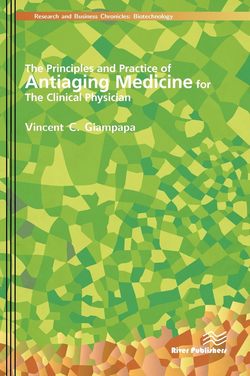Читать книгу The Principles and Practice of Antiaging Medicine for the Clinical Physician - Dr. Vincent C. Giampapa - Страница 29
На сайте Литреса книга снята с продажи.
Оглавление5
Diet and Aging
Vincent C. Giampapa, M.D., F.A.C.S.
Every man takes the limits of his own field of vision for the limits of the world.
Schopenhauer
The Basic Facts
The primary purpose of altering our diet as we age is essentially an attempt to activate more of our genetic potential by positively influencing our gene expression with the food we eat (Diagram V-1). This means that unhealthy eating habits result in poor gene activation and “turn on” the genes responsible for accelerated aging and disease. At present, the only scientifically documented means of slowing aging is through dietary changes and more specifically caloric restriction. The essential component of this approach is decreasing glucose utilization at the cellular level.1–12 The good news is that changing our diet can be as easy as upgrading our computer software.
The second important concept to keep in mind is that an anti-aging diet is significantly different than a weight loss diet. The key efforts of an anti-aging diet focus on not losing weight but, more importantly, on altering body composition to a more youthful level. This altered body composition focuses mainly on decreasing body fat and increasing muscle mass. When we accomplish this type of alteration in body composition, a number of key events take place:
1. There is an improvement in our ability to burn calories more efficiently because, with increased muscle mass and less body fat, caloric burn rates are much higher, as in younger people.
2. We attain a more optimal body mass index (BMI) and body composition, resulting in a decreased number of age-related diseases (Diagrams V-2a to V-2c).
3. We experience an improved level of functionality, or quality of life as we age.
4. We maintain the optimal production and levels of key anti-aging hormones, which have a direct impact on the rate and quality of aging. These key hormones, basically, are growth hormone, insulin-like growth factor (IGF)–1, insulin, glucagon, and cortisol.
Another essential goal of an anti-aging dietary program is to improve genetic expression by protecting deoxyribonucleic acid (DNA) from damage by excessive free radical (oxidative stress) production.
An often underemphasized and essential component of this special anti-aging diet is maintaining ideal pH levels at both the intracellular and the extracellular levels. The importance of this point cannot be emphasized enough!
Acidification of cellular fluids results in premature aging at the molecular, genetic and tissue levels. An increased incidence of viral, bacterial and even cancerous growths occurs when the biological terrain becomes overactivated. Computerized tools to measure the biological terrain have been available for years but are just now becoming accepted in mainstream medicine.13 This is the most prevalent problem in America and in all industrialized countries in general.
The purpose of food, in general, is to create energy for the cellular processes that are required to maintain normal body function and maintenance as well as cell regeneration.
Utilizing these key concepts in an anti-aging diet supplies the information needed to fine-tune hormonal responses as well as our genetic potential. By taking a few essential steps, we can easily improve the efficiency of our aging metabolism as well as our quality of health.
For most people, decreasing body fat and maintaining a more youthful body composition with more muscle mass requires a few relatively simple steps:
